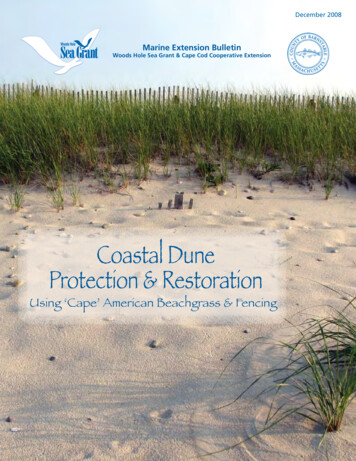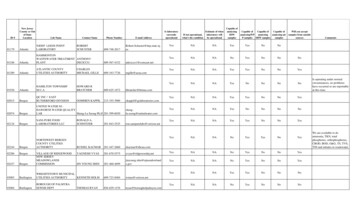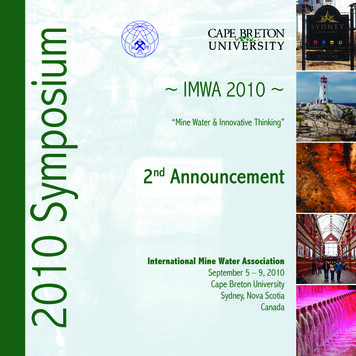
Transcription
December 2008Marine Extension BulletinWoods Hole Sea Grant & Cape Cod Cooperative ExtensionCoastal DuneProtection & RestorationUsing ‘Cape’ American Beachgrass & Fencing
The Origin ofCape American BeachgrassThe term ‘Cape’ American beachgrass, in place ofsimply American beachgrass, is used extensivelythroughout this bulletin. The USDA Soil Conservation Service (now the Natural Resources ConservationService) tested a collection of American beachgrasswhich performed extremely well on sand dunes alongthe oceanfront. Named after its place of origin, CapeCod, Massachusetts, it was released to the commercial market in 1971. ‘Cape’ is considered the industrystandard and has proven to out-perform all othervarieties for conservation applications from Maineto North Carolina (USDA, NRCS, 2006).
Coastal Dune Protection & RestorationThis bulletin addresses restoration of the dynamic frontal coastal sand dune system withsand fencing and ‘Cape’ American beachgrass. Other typical Northeast area dune plants,such as Rosa Rugosa, Bayberry, and Beach Plum occupy more stable secondary and backdune areas (Clark and Clark, 2008).Table of ContentsTwo Hundred Years of Planting ‘Cape’American Beachgrass on Dunes1Planning Dune Restoration: ImportedSand or Sand Fence & Vegetation2Survival of ‘Cape’ American Beachgrass11Preserving Shorebird Habitat11Permitting12Potential Adverse Considerations ofDune Building and Restoration Permits12Management of Pedestrian Trafficin Heavy Use Areas13Acknowledgements14Additional Resources14References15By Jim O’ConnellWoods Hole Sea Grant & Cape Cod Cooperative ExtensionEdited by Jeffrey Brodeur, Woods Hole Sea Grant
Two Hundred Years of Planting ‘Cape’ AmericanBeachgrass for Dune StabilizationIn 1714, after clearing thickly forested areas of theProvince Lands for fuel, fence posts, fish weirs, andburning for croplands, colonists recognized that lackof dune vegetation created blowing sand that wasthreatening Provincetown and Provincetown Harbor, and they began planting beach grass and placingpine branches to stabilize the dunes (Knutson andFinkelstein, 1987.) In 1904, Massachusetts hunters introduced ‘Cape Cod Grass,’ brought from NewEngland, to the Outer Banks of North Carolina. Today,sources of ‘Cape’ American beachgrass exist from Massachusetts to North Carolina.Why are frontal coastal dunes soimportant? Coastal dunes: Provide landward areas by acting as abarrier to storm surge and flooding Provide significant wildlife habitat Provide a reservoir of sand thatnourishes eroding beaches and feedsnearshore sand bars during stormsThe beneficial functions of coastal dunes result fromtheir ability to move and change shape and supply areservoir of sand to the fronting beach during coastalstorms. Dunes and beaches dissipate storm wave energy — minimizing effects to landward areas — in aninteraction known as dynamic equilibrium.1Figure 1. Natural and artificially stabilized dunes provide protectionto landward development and limit storm impacts to landward coastalresources.Sand dunes provide unique wildlife habitat. Dunes alsoact as a barrier to storm surges and flooding, protectinglandward development and limiting storm wave effectson landward coastal resources. During storms, coastaldunes erode and nourish fronting and downdriftbeaches and nearshore sand bars. Sand bars, beachesand dunes interact within the larger coastal landformsystem, each exchanging sand while changing formand shape — an interaction that dissipates storm waveenergy. As the storm diminishes and waves become lesssteep, nearshore sand bars migrate landward and weldonto the beach. Finer-grained sand is then wind-blownback into the dune area to naturally rebuild the dunes.However, the natural dune-rebuilding process cantake several years, and it may be desirable to rebuild astorm-eroded dune quicker than natural processes.
Planning Dune Restoration:Imported Sand or Sand Fence & VegetationBefore beginning a dunes restorationproject, check with your local conservationcommission. See “Permitting”on page 12.To naturally rebuild a dune, it is important to initiallydetermine whether there is sufficient volume of windblown sand available. Nearby accumulation aroundsand fences or the general condition of adjacent dunescan indicate availability of wind-blown sand. For example, moderately sized 3’ to 8’ or higher dunes in theinterdune or back dune areas, with undulating sandsurfaces and moderate to dense vegetation, would suggest available wind-blown sand.Figure 2. Building a dune with imported quarry sand (Duxbury Beach,Mass.).If wind-blown sand is available, install sand fence andplants, based on a sketch of the area. If not, importclean sand of compatible grain size to build the dune.After the sand is shaped, sand fencing and plantingscan take place.Dune Rebuilding with Imported SandThrough experimentation at their nearly five-mile longbeach, the Duxbury Beach Reservation, Inc., in Massachusetts discovered a method to rebuild an artificialdune with imported quarry sand that is also appealing to shorebird habitat. The organization covered thequarry sand with approximately six inches of nativedune sand, then planted vegetation on the natural sandveneer to create a natural appearing dune. (Figures2-5, DBR Management Plan, 2003.)Figure 3. Covering quarry sand with natural dune sand.The native dune sand was obtained from a landward,more stable, dune area land and the borrow area subsequently filled with quarry sand and recovered withnative sand.It is interesting to note that the Duxbury Beach Reservation, Inc. is now nourishing/rebuilding the backsideof frontal dunes, not the eroded frontal dune scarp.Figure 4. Planting the artificial dune with beachgrass.2
approach works with landward migrating barrier beachprocesses.Another example of rebuilding a frontal dune withtrucked-in sand and the installation of sturdy sanddrift fences can be seen in Figure 6 in Brewster, Massachusetts. Minor renourishment took place followinginitial construction and the dune continues to providestorm and flood protection to the landward dwellings.It should be noted, however, that this dune restorationproject was on the immediate updrift side of a stone/riprap groin so the beach was wider in that particularlocation.Figure 5. Artificially built dune naturally revegetating.Begin dune building farthest landward from meanhigh water as possible.Natural vegetated coastal dunes are found a specificdistance landward of mean high water. That distance isbased primarily on the landward limit and frequency ofseasonal storm tides and wave inundation up the beachface, because storm tides and waves prevent vegetationfrom growing.Plant vegetation at least 100 feet or greater landward of mean high water.Figure 6. An artificial dune 18 months after construction.After many years of rebuilding the eroded frontal dunescarp, only to have sand erode during the next moderate storm, members realized that dune rebuilding wastaking place too far seaward for protection and longevity. The dune was frequently inundated and eroded bystorm wave uprush. Natural processes were suggestinga more landward location optimum for survival of thefrontal dune. That optimum landward dune locationis often landward of the seasonal average storm tideelevation. This elevation can generally be recognizedby observing the landward toe of other frontal dunesalong that section of beach.Thus, the procedure now for rebuilding frontal duneson Duxbury Beach following storms is to rebuild thebackside of the frontal dune, not the seaward side. This3Less frequent storm waves at this distance allows windblown sand time to build dune volume and for the rootsof stabilizing dune vegetation to grow. If a 100-footbuffer is not possible, begin building a dune the farthest possible distance landward from mean high water,landward of the average seasonal storm inundation area.Adjacent seaward dune vegetation generally indicatesthe average seasonal storm tide limits.Sand Fences vs. ‘Cape’ American BeachgrassSand fences initially trap higher volumes of sand than‘Cape’ American beachgrass alone. ‘Cape’ Americanbeachgrass traps little sand during the first growingseason. Once established however, ‘Cape’ Americanbeachgrass traps sand at a rate comparable to multiplesand fences (Knutson, 1980).Adding spurs to a straight sand fence, building zigzagfence configurations, or perpendicular or oblique configurations do not measurably improve long-term fenceperformance, and increases construction costs (Knutson,1980; Miller, et al, 2001.)
PostsInstalling initial sand fencing or plantingstoo close to the sea will result in thecapture of wind-blown sand at theextreme seaward portion of the beachberm, preventing the sand from reachingand building the existing erodedforedune. This will subject the newfence and plants to more frequent storminundation and potential loss. Begin dunerestoration as far landward as possible!In experiments on Cape Cod, planted dunes producedlower and wider dunes than fence-built dunes (Knudson, 1980). Gently sloping, wider seaward-facingdunes are less prone than steep slopes to wave-inducedscarping and loss of sand from storms.Rebuilding a frontal duneSTEP 1: Draw a sketch of the dune restorationareaA sketch can be a simple drawing based on visual observations along with on-the-ground measurements ofthe dune restoration area made using a tape measure.A sketch could also be made on an aerial photo or satellite image. If sufficient funds are available, a surveywith engineering drawings can be obtained, however,the expense may not be justified, or necessary, forsmaller projects.Install sand fence posts at or within several feet seaward of the toe of the dune scarp. If the dune is highand the seaward dune scarp is not too steep, a fencecould be installed partway up the seaward dune faceto add volume to the existing dune. The posts shouldbe buried several feet into the sand to withstand occasional small wave energy—minimum depth of 4’ isoptimum. Shallow posts could by dislodged easily bystrong winds or waves. Posts to hold the fencing rangefrom metal garden stakes, 2x4 posts, 4x4 posts, and 6”to 8” round timber piles. 2x4 posts should be installedwith the narrow (2”) end facing seaward to minimizewind and wave effects on its stability.Various size posts can be used. The diameter of thepost depends on whether the site is located in a highenergy area where the fence may be subject to wave orsignificant wind action, and also the amount of fundsavailable. If it is expected that the site will be inundatedby waves, larger size posts (4x4 or 6x8 round piles)should be considered with adequate depth embedment.Attach the initial sand/snow fence to the posts with1.5” to 2” galvanized staples, attaching the fence wireto the post, or nail the fence slat directly to the post.On the sketch, draw the locations of sand fencing andareas for planting dune vegetation, and measure thelinear length of fence and numbers of culms (a culmis one single plant stem) desired, based on the plantspacing chosen (see Plant Spacing in Step 3.)Follow this same approach for 18”, 24” or 36” oncenter culm planting.STEP 2: Install sand/snow fence in specific location.Sand fencing is used to both capture wind-blown sandto build a dune and also to control pedestrian trafficand keep people off the fragile dune vegetation.Figure 7. Ted Keon, Director of Coastal Resources for Chatham, Mass.,uses a shovel for larger size holes for 6x8 poles while project manager TimFriary looks on.4
Figure 8. Using an excavator to dig larger size holes for 6”to 8” poles,Duxbury Beach, Mass.Figure 12. Fence is attached to 6” diameter posts.Figure 9. Fence arrives on Duxbury Beach, Mass. in 50’ rolls.Figure 13. Experienced sand fence installers Joe Grady and Dick Sjostedtattach fencing to posts. The snow fence is being held taut by a crow barwhile a 2” galvanized staple is hammered into the post loosely attachingthe snow fence ‘wire’ to the post.Wire wrapped around the back of the postFigure 10. Installing 6” piles for a double row of slat style fence.Fencesupportwire2.5” stapleFigure 11. Fence is laid-out.5Figure 14. A wire is wrapped around the back of the post and is attachedto the sand fence wire approximately 8” to either side. This adds supportto the fence under strong wind conditions. A loose attachment allows thefence wire to slide and move to prevent breakage as wind shakes the fence.
Sand Fence VarietiesThere are a variety of sand fence materials including wood, plastic, polyethylene, and metal. There arealso many varieties and sizes of sand fencing, from thetypical slat-type sand/snow fencing (Figure 15), to 2x3vertical and horizontal fence members.Regardless of sand fence slat size, a 50-50 ratio of openspace to slats spacing between vertical members appearsto perform similarly in terms of sand volume capture.Larger sizing of slats or posts (i.e. 2x3 slats and 6”posts), or having two parallel fence rows may withstand small wave action, but adds to overall expense.Begin landward and over time build the existing foredune seaward in incremental steps. As one sand fencefills approximately two-thirds high, install anotherfence slightly seaward on the newly deposited sand(Figure 16).Optional second initial fenceIn addition to one sand fence placed at, or several feetseaward, of the existing dune scarp, a second sandfence could be installed one half to two-thirds up anun-vegetated foredune slope or dune scarp. Depending on the dune slope and size, and ability to install afence up the dune slope, a second fence may expeditesand accumulation on larger dunes.Dune building with sand fences in overwash areasFigure 15. Sand/snow fence held to 2x4 posts with tie-wraps, an alternatemethod of installation.Begin dune building and planting as farlandward as possible, as installing initial sandfencing or plantings too far seaward will: Capture wind-blown sand at that moreseaward location on the beach bermand prevent that sand from reachingand building the existing eroded foreduneleaving it vulnerable Subject the new, more seaward fence andplants to more frequent storm inundationand potential lossAn overwash occurs when storm waves overtop thebeach berm and generally break through and flattendunes. The storm wave uprush does not return to seabut continues landward and deposits sand in a flat,fan-shaped deposit. Overwash areas in Massachusettsare often prime piping plover or tern habitat which arerigorously protected by law in Massachusetts. Beforeconducting any activity in an overwash area, checkwith your local conservation commission.If dunes have completely eroded, significantlylowered in elevation, and/or overwashed, dune rebuilding should begin approximately mid-way intothe overwash fan by installing the first sand fence,in association with planting rows of ‘Cape’ Americanbeachgrass (detailed in the next section). When thefirst sand fence fills approximately two-thirds high,install another fence at the rebuilt seaward dune toe.Continue progressively building the dune seaward byadding sand fence ‘lifts’ (Figure 16).Dunes generally grow towards the direction of maximum sand source. In Massachusetts, if a source isavailable, sand will be blown from the prevailingnorth-northwest direction in winter, and south-southwest direction in summer. Predominant east-northeastwinter storms will move sand during brief winterstorms. Because dune restoration generally takes place6
FeetMetersElevation above MSL (mean sea level)620Ocean1854Sand fence “lifts”1668 months1440 months12316 months102 months82160 eetMetersDistance from base lineFigure 16. Building a dune through sand accumulation by installing additional sand fences, as previousy installed fence fills to approximately two-thirds.A series of four sand fence lifts is shown (from Savage and Woodhouse, 1969, in ACOE,1984).Figure 17. Sturdy sand drift fence made of 2x3 vertical and horizontalmembers, with 6” diameter posts.7Figure 18. Double row of sturdy sand drift fence — made of 2x3 verticaland horizontal rows with 6” diameter posts which are partially buriedwhen installed. This style of fence is generally used in areas of small wavesor ice.
on the seaward dune scarp (which gets eroded during a coastal storm) and the landward dunes generallyremain vegetated, the primary sand source is generally from the seaward direction, i.e., the beach. Somevolume of sand, however, will blow from the prevailing west wind direction and build the backside of thedune.available and the presence or absence of protectedshorebird habitat. Less dense plantings are generallyrequired in shorebird habitat areas, generally 36” oncenter culms.Estimating Plant NumbersCalculate the square footage of the area to be planted.STEP 3: Planting ‘Cape’ American Beachgrass‘Cape’ American beachgrass (Ammophila breviligulata)is the dominant dune building plant along the NorthAtlantic Coast from Maine to North Carolina and alongthe Great Lakes (Knutson and Finkelstein, 1987).The almost perfect performance and ease of establishment of ‘Cape’ American beachgrass has escalated thisplant to being literally the only species extensivelyplanted on coastal sand dunes — particularly the frontal dune — from Maine to North Carolina (Miller andSkaradek, undated, NRCS, Cape May Plant MaterialsCenter).Plant Spacing‘Cape’ American beachgrass is generally planted 12”,18”, 24”, or 36” on-center, in a minimum, if possible,of 10 parallel staggered rows. Plant spacing dependson the desired location of maximum sand accumulation and elevation. Closer spaced plants capturesand quicker. Spacing is based on number of plantsFigure 19. Planting ‘Cape’ American beachgrass requires only a pogo-typehole poker (any pole or stick several feet long will do), and culmsof beach grass (100 culms in a bundle as shown). Note the horizontal baron the pogo stick is approximately 8” inches up from the bottom for easeof ensuing proper depth of the hole. Makai O’Connell planting beachgrasson Duxbury Beach, Mass.Determine the plant spacing desired, e.g. 12”, 18”, 24”,or 36”. Recall that more dense plant spacing, e.g. 12”,traps more sand. Make sure that the highest density ofbeachgrass plant spacing is where the highest volumeof sand is desired.Example: If the area to be planted is 10’ x 10’ 100square feet: 1 plant hole per square foot 100 plant holes 3 culms per hole 300 culms of beach grass areneeded.Due to the dense configuration of 12”spacing, one or two culms per hole can besufficient, rather than the suggested twoto three culms per hole for wider spacing.Figure 20. Individual culms are generally planted 8” to 10” deep withtwo or three culms per hole. A culm is a single plant, often with two stems.8
Planting GuidelinesRapid dune stabilization or steep slopes — Planttwo or three culms per hole at 12” to 18” spacing.Rare, threatened or endangered shorebird (e.g. piping plover) habitat areas — Planting any vegetationwill be significantly limited — generally 36” plantson-center is required — if planting is allowed at all.In Massachusetts, maps of potential and actual rarespecies habitat are available through your local conservation commission.If your dune restoration project is within a habitat, awritten opinion from the Massachusetts Division ofFisheries and Wildlife’s Natural Heritage and Endangered Species Program is required before authorizationfor restoration is granted. They will determine whetheryour project will have a short or long-term impact onrare wildlife habitat.Maximum dune width — Plant spacing densities canbe the same throughout a project area or, if space allows, can be graduated from landward dense spacingto gradually wider spacing moving seaward to obtainmaximum dune width (Figure 22).Obtaining Maximum Dune WidthIn North Carolina, researchers found that decreasingthe spacing of plants both landward and seaward fromthe dune crest increased dune width and reduced theseaward slope of the dune from about 10 percent to 5percent (Savage and Woodhouse, 1968).As shown in Figure 22, the most dense plant spacingare in the landwardmost location, with decreasing plantspacing or density moving seaward. This method willbegin dune formation in the landwardmost area andwill grow the dune seaward, resulting in a wide stabledune.Keep in mind that a dune will grow in the direction ofthe source of wind-blown sand. Due to the open beacharea, the source will generally be from the seawarddirection.9Figure 21. Planting foredune scarps is particularly important.Planting Season: November 1 through AprilOptimum planting season for ‘Cape’ American Beachgrass from Massachusetts to North Carolina is late fallto early spring. A cut-off date of April 1 is recommended for more southern areas in this range (Fournier,NRCS, undated), and April 15 for the more northernMassachusetts areas (Tim Friary, personal communication, 2008). This seasonal constraint is due to bothweather conditions and rare shorebird nesting behavioral disruptions. The temperature and rainfall duringthe summer months are too warm and dry to support abare root plant (Church’s Garden’s Center, 2008).An optimum planting time for increasing plant survivalmay be early to mid-March. In addition, April 1 isgenerally a planting cut-off date to avoid disruption topiping plover nesting behavior.STEP 4: FertilizingFertilizer may easily leach through porous sand andpollute groundwater nearby bays or estuaries causingwater quality problems. Use of slow-release fertilizeris recommended. However, technical literature recommends various amounts of fertilizer, as detailed below.Properly applying fertilizer is the key to good vigorousinitial growth of newly established stands of American Beachgrass (USDA, NRC, Plant Fact Sheet, 2006).Fertilizer stimulates growth, increases stems and accelerates the spread of rhizomes. Inorganic, granular
Future duneSpace culms36”apartSpace culms18” – 24”apartSpace culms12”apartFigure 22. Graduated plant spacing seaward increase dune width and concentrates dune volume and height in the more densly planted area.fertilizers high in nitrogen are best (N-P-K 30-10-0,16-8-8 or 10-10-10). Apply no more than one poundN/1000 square feet in a single application (USDA,NRCS, Plant Guide, 2006).USDA, NRCS (2006) recommends applications providing between 30-60 lbs of nitrogen per acre annually.Splitting applications into spring and early summer ismore effective. Spring application should be appliedat least 30 days after establishment, but not later thanApril 1. Once the stand is established, the rate can bereduced by half, or applied only when the stand appears to be weakening.USDA, SCS, also recommends using 600 lbs of10-10-10 fertilizer per acre (14 lbs per 1,000 sq. ft. 30days after planting, but not before April 1.Cape Cod Organic Farms recommends only 100 lbs of10-10-10 fertilizer per acre. Even this lower applicationrate has resulted in a 10-fold increase in stem density(Tim Friary, personal communication, 2008).Cape Cod Cooperative Extension suggests using 25to 60 lbs of nitrogen per acre annually as adequate.Results are more effective if applied in two applications:one in spring within 30 days of planting, but beforeApril 1; another application in late summer or earlyfall (American Beach Grass Plant – Plant Spacing FactSheet).For the first year following planting American beachgrass, North Carolina Sea Grant recommends applying4 lbs of 30-10-0 or 7 lbs of 16-4-8 fertilizer per 1,000square feet in March or April and again in September.The second year, apply 4 lbs of 30-10-0 or 7 lbs of16-4-8 fertilizer per 1,000 sq. ft. in March and againin September (NC Sea Grant, 2003). Fertilize only ifnecessary after two years.STEP 5: Monitoring (optional)Monitor through documentation of dune evolution. ADVD explaining how to monitor dune and beach profiles, “Dune and Beach Profiling: Training in the Use ofthe Emory and O’Emory Rod Methods”, is available freefrom Woods Hole Sea Grant or Cape Cod CooperativeExtension.STEP 6: MaintenanceAdd sand lost due to storms (optional).Replace fence and plants as needed and spread fertilizerin second year.10
Survival of ‘Cape’ American Beachgrass‘Cape’ American beachgrass evolved in areas of dunesystems that experience sand accretion. Moderatesand burial processes stimulate new plant growth,and also bury the old leaves and vegetative materials,thus eliminating thatch build-up and pathogen harbor(NRCS, Cape May PMC, undated). If sufficient windblown sand is not available at a particular site, ‘Cape’American beachgrass may only survive for a couple ofgrowing seasons. More frequent maintenance and plantreplacement may be necessary under these conditions.Incorporating seed of other dune plants into the areamay also help stabilize these sand deficit areas.As dunes mature and advance seaward, sand accumulation slows, depriving the established beachgrass itsneeded nutrients. Often the result is a decline in thehealth of plants in older stands. Over a 30-40 yearperiod it has been observed that throughout its nativerange, American beachgrass is susceptible to declineafter six to eight years when artificially established(Miller and Skaradek, Cape May PMC). Dunes willadvance in the direction of wind-blown sand, generallyseaward, until equilibrium is reached with seasonalfrequency of storm wave inundation.American beachgrass has been shown to be able togrow through at least a foot — and possibly two —of overwash sand and survive saltwater inundation(Knutson, 1980).Preserving Shorebird Habitatunvegetated or, at most, planted with beachgrass at 36”spacing. For foredune slopes between 10:1 and 6:1,consultation with your local conservation commissionor state shorebird specialists should take place prior tosubmitting an application (Notice of Intent) to conductdune planting.In Massachusetts, advice should be obtained fromthe Massachusetts Division of Fisheries and Wildlife’sNatural Heritage and Endangered Species Program forplanting gently sloping foredune areas.Figure 23. Preserve piping plover habitat and areas for pioneer beach anddune vegetation growth fronting the foredune by roping off the area.The area immediately fronting foredunes for 20 or sofeet seaward and overwash areas, particularly on barrier beaches, are often prime shorebird nesting habitat,particularly for the threatened piping plover. Pipingplovers prefer relatively flat, unvegetated or sparselyvegetated sandy/pebble/cobble mixed sediment beachand dune areas. Thus, foredune slopes 10:1 are criticalnesting habitat and generally are required to remain11Preserving a 20-foot buffer zone of beach fronting foredunes to protect prime piping plover nesting habitat,and allowing an area for seaward pioneer vegetationgrowth, particularly on barrier beaches, is advisable.On Duxbury Beach, sand fence and temporary symbolic fencing (orange string tied to metal posts with signs)are maintained in order to preserve plover nestinghabitat and allow pioneer vegetation to grow seawardThese measures keep pedestrians and off-road vehicles(ORV) out of these important areas.
PermittingIn Massachusetts, authorization, generally a permitknown as an Order of Conditions, must be obtainedfrom the town conservation commission for anyactivity in or adjacent to a coastal dune, includingrestoration.opinion must be obtained from the Massachusetts Division of Fisheries and Wildlife’s Natural Heritage andEndangered Species Program advising on the potentialshort- and/or long-term impacts to protected shorebirdhabitat.However, before the local conservation commission canmake a determination on issuing a permit, a writtenPotential Adverse Considerationsof Dune Building and RestorationConsiderationsu Sand dunes will slow but not prevent erosion.u Dunes can provide significant protection fromstorm surge. But along an eroding shore stormwaves will eventually overtop or erode dunes.u Dune restoration, while a preferred and oftentimeseffective protective measure, requires maintenance.u If a dune or vegetation are placed father seawardthan adjacent dunes (or approximately 100’ landward of mean high water) the plants and dune willbe subject to frequent wave inundation and potential loss.u Discarded Christmas trees are not effective inmaintaining a coastal dune under storm condi tions.It has been shown that storm waves dislodge theburied trees, rapidly removing all accumulatedwind-blown sand.Large successful dune building projectshave been shown to: Change adjacent micro-climateaffecting ecology and adverselyimpacting coastal plant communities(Knutson and Finkelstein, 1987). Prevent barrier beach/barrier islandmigration by reducing frequency ofoverwash Lower landward areas by preventing orreducing overwash Potentially have negative impact on saltmarsh vertical growth by preventingsand transport to the landward marshsurface12
Management of Pedestrian Traffic in Heavy Use AreasAll-weather outdoor signs help educate and orient pedestriantraffic out of dune areas and are available free of charge fromWoods Hole Sea Grant and Cape Cod Cooperative Extension.13
AcknowledgementsThe following individuals are thanked for improvingthe content of this bulletin: Joseph Grady, ConservationAdministrator, Town of Duxbury, Mass., and a DuxburyBeach Reservation, Inc. Trustee; Tim Friary, owner ofCape Organic Farm, Barnstable, Mass.; Henry Lindh,Director, Department of Natural Resources, Eastham,Mass.; Kate Madin and Jeffrey Brodeur, Woods Hole SeaGrant, Woods Hole, Mass.; and, Bill Clark, Director,Cape Cod Cooperative Extension, Barnstable, Mass.Joe Grady is particularly acknowledged for providing technical advice on beachgrass planting and sandfence installation techniques developed over 30 yearsof annual installation of several miles of sand fence andcoordinating the annual planting of Cape Americanbeachgrass on Duxbury Beach.Addition
dune with imported quarry sand that is also appeal-ing to shorebird habitat. The organization covered the quarry sand with approximately six inches of native dune sand, then planted vegetation on the natural sand veneer to create a natural appearing dune. (Figures 2-5, DBR Management Plan, 2003.) The native dune sand was obtained from a landward,










